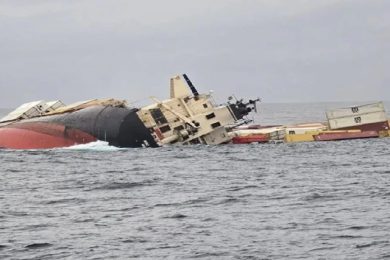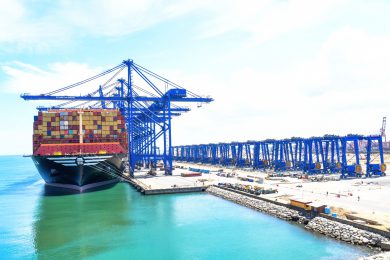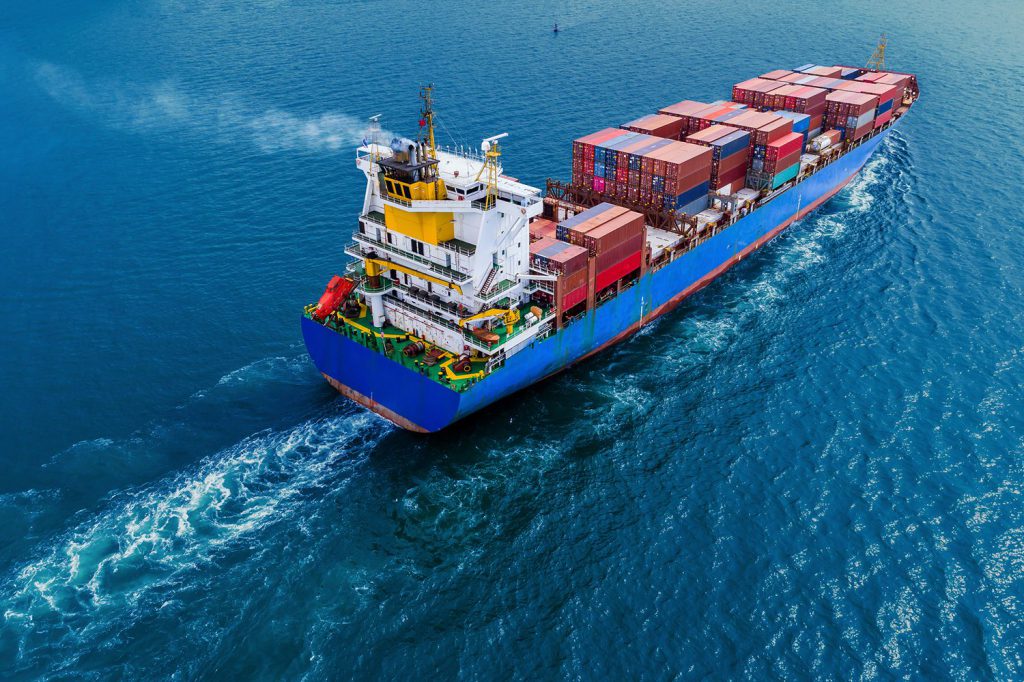UNCTAD’s Review of Maritime Transport 2022: Facts and Figures on Asia and The Pacific
The United Nations Conference on Trade and Development releases today the Review of Maritime Transport 2022.
Trends in maritime trade
- In 2021, around 40% of total containerized trade was on the main East-West routes – between Asia, Europe and the United States. Non-mainlane East-West routes such as South Asia-Mediterranean accounted for 12.9%.
- Performance across container shipping lanes also varied depending on the direction of trade – headhaul or backhaul. Volumes on the Transpacific route increased by 15%, reflecting a 20% growth on the peak East Asia to North America leg. Meanwhile, trade on the backhaul journey fell by 1.6%. Trade on the Asia-Europe route increased by 10%, supported by growing volumes from East-Asia to Europe (14.7%).
- In 2021, Asian container exporters were among the top five, accounting for almost half the traffic, and included China, Viet Nam, the Republic of Korea and Japan.
- Trade in iron ore depends heavily on developments in China, and in 2021 it grew only marginally, by 1%, China accounted for about 73% of world iron ore imports – a share above the pre-pandemic level.
Fleet developments and supply
- The ranking of fleet ownership and registration is more volatile in terms of commercial value than in tonnage. China registered the highest increase in share, of 1.1 percentage points, followed by Switzerland, Hong Kong China and the Republic of Korea, whose fleets have a higher proportion of container ships.
- As of 1 January 2022, the top three ship-owning countries, in terms of both dead-weight tonnage and of commercial value, included two Asian countries, namely China and Japan.
- In the 12 months to 1 January 2022, China recorded the second highest increase in tonnage (13%) among the top 25 ship-owning countries.
- Among the top six registries, ships registered in Panama, followed by China, had the highest average age of total fleet. The lowest was for Marshall Islands followed by Singapore. Differences in age reflect differences in registries’ policies, pricing structure and specialization in different ship types.
- Maritime ship supply continues to be dominated by three countries – China, the Republic of Korea and Japan, which in 2022 together had 94% of the market. Over the past year, shipbuilding increased in China by 15.5% and in the Republic of Korea by 8.3 %, but in Japan it declined by 16.4%.
- In June 2022, the four main economies ordering alternative fuel-capable ships were the Republic of Korea at 70% of their orders, China at 26%, Europe at 58%, and Japan at 17%.
- In Bangladesh, the 2019 Flag Vessels Protection Act provided for 50% of cargos to be carried by local vessels, which would have VAT exemption and berthing priority at local ports. The aim was to promote investment by local entrepreneurs, increase transport supply capacity and relieve bottlenecks in trading operations in key export routes. In 2020, the national fleet grew in deadweight tonnage by 18% and in 2021 by 19%.
- In Viet Nam,the Ministry of Industry and Trade proposed several measures aimed at easing supply chain issues along intra-Asian routes and reducing the burden on traders. These included tax incentives to attract foreign investment in new ships and to encourage private-sector investment in key infrastructure upgrades, as well as measures to encourage fleet renewal and the development of a coastal fleet management programme.
Disruption from the COVID-19 pandemic
- In 2021, maritime trade recovery was disrupted by supply chain problems, then in 2022 the situation deteriorated further with the impact of recurrent COVID-19 infections, especially in China, and labour strikes in ports and the logistics sector, including in the Republic of Korea. In 2022, there were new waves of COVID-19 infections that further disrupted supply chains, particularly in China, which had a zero-COVID policy.
- China’s zero-COVID policy resulted in lockdowns in two of China’s largest manufacturing and commercial centres, Shenzhen and Shanghai. Ports in these cities remained open, but the lockdowns disrupted manufacturing, trucking and logistics operations. Carriers had to reroute via alternate ports such as Ningbo. By. By mid-2022, prices as measured by the Shanghai container freight index (SCFI) were more than five times their 2019 level.
- Some regions managed the crisis better than others. For example, India strengthened connections and upgraded port capacity, including by launching dwarf-container train services. To take advantage of the congestion crisis in Sri Lanka, India is planning to deepen the channel of Cochin Port.
Freight rates
- In December 2019, the SCFI stood at 898 points but by December 2020 was 2,455 and by in December 2021 was nearly 5,000.
- In September 2019, on the Shanghai to New York (Asia – North America East Coast) route, the cost of shipping a large container per 40-foot-equivalent unit (TEU) was $2,325. In December 2020, the cost was $3,979, but by September 2021 it was $11,778.
- On the China to South America (Santos) route in December 2019, the average rate per TEU was less than $2,000, but by December 2020 it had risen to $6,543 and by December 2021 was $10,196. Similarly, between December 2020 and December 2021, on the Shanghai to South Africa (Durban) route the rate per TEU increased from $2,521 to $6,450, and on the Shanghai to West Africa (Lagos) route from $5,291 to $7,452.
- Overall freight levels for China’s export container transport market, including spot and contractual rates, are reflected in the broader China containerized freight index (CCFI). In December 2019, this stood at 848 points, but by December 2020 had reached 1,492 points, and by December 2021 was 3,265 points.
- High freight rates on the East-West trade lanes attracted smaller regional container operators into the market, including the Chinese regional carriers CULines, BAL Container Line and Shanghai Jin Jiang Shipping (SJJ), which started ad hoc Asia-North America, Asia-Europe, Asia-South America or Asia-Australia services.
- On the Asia-North America West Coast non-alliance services amounted to around 30% of all deployed capacity – higher than for 2M and THE Alliance shares and nearly as much as that of the Ocean Alliance. Non-alliance services were less significant on the Asia-North America East Coast trade route with only a 10% market share, and on the Asia-Europe routes with less than 1%.
- Between 2020 and 2021, there were significant variations in freight rates across different routes including inter-regional routes. For the Asia-Europe leg, rates under contracts increased more than 70%, for the Asia-North America routes by 41%, and for the intra-Asia routes by 46%. These increases were driven by greater demand for container shipping and equipment, shortages of carrying capacity at Asian ports, temporary blockages of the Suez Canal and COVID-19-related disruption at major Chinese ports.
Performance indicators
- In 2021, the largest increase in container ship time spent in port was in Singapore at 29%, followed by Panama, Taiwan Province of China, Hong Kong China, Malaysia, France, the United States and China. Some transhipment freight was sent to Singapore without on-time connecting vessels to load the containers – disrupting shipping schedules and resulting in container shortages in other Asian economies.
- Longer times in port reduced efficiency and shipping lines tried to avoid some congested ports. Some container ships for the China-EU trade lane have bypassed the refuelling hub in Singapore and bunkered in China to save time.
- Viet Nam and Philippines recorded similar increases in the number of port calls, driven by strong growth of exports, mainly of electronic products. Viet Nam’s export volume increased by 15.6% in 2021, with mobile phones, computers and electronics accounting for a third of total exports. Philippines export volume increased by 5.3%, with electronic products forming two thirds of the total.
- The first two years of the pandemic saw declines in port calls in Eastern Asia. Scheduled port calls increased in Eastern Asia to meet increased container shipping demand, but actual port calls declined due to serious port congestion and container shortages.
- Among the 25 highest-ranked container ports, six were in Western Asia. For East Asia, reflecting congestion, the number of ports in the top 25 decreased from 15 to eight.
- In terms of cargo handling productivity of cape size dry bulk carriers, countries in South Asia (India) and Western Asia (Qatar, Bahrain and the United Arab Emirates) had performances lower than the global average. For handy size dry bulk carriers, eight of the top 10 port call economies, including China and Japan, had average or higher cargo handling productivity. Indonesia was the exception in Asia.
- Very large crude carriers (VLCC) showed different patterns. The highest-performing economies were in Western Asia – Qatar, the United Arab Emirates, Kuwait and Saudi Arabia – although Oman and Iraq had lower-than-average performances.
- The Philippines Ports Authority is responsible for more than 400 trading ports and is offering concession opportunities supported by the global operational benchmarks available from the UNCTAD Port Performance Scorecard (PPS).
- The PPS disaggregates data by gender and shows that the port industry as a whole is still dominated by men. In 2021, the median value for female participation in port management was 42% globally – and in Asia 60%.
- In the second quarter of 2022, the four most-connected economies, with the highest scores on the Liner Shipping Connectivity Index (LSCI), were in Asia – China, the Republic of Korea, Singapore and Malaysia. China widened its lead as more vessel capacity had been redeployed to the United States trade routes.
- Hong Kong China dropped from fifth to tenth between the second quarters of 2021 and 2022 as large container vessels serving the China-EU route started skipping this port. Japan faced the same problem earlier; its rank dropped from 11th to 21st between the first quarter of 2021 and the second quarter of 2022.
- Asia and Oceania, as a whole continued their positive trends in their LSCI scores, led by China
- Intra-regional shipping connections increased in Southern Asia – as India strengthened connections to Pakistan, Sri Lanka, China, the Republic of Korea, Malaysia, Saudi Arabia, the United Arab Emirates and Singapore. Jawaharlal Nehru port and Mundra port in India secured several additional connections facilitated by port expansions and upgrades including the launch of dwarf-container train services. Dwarf containers are lower by 660 millimetres than the normal containers, giving them a logistical edge in rural, semi-urban and urban roads.
- Over the past decade the largest CO2 emission increases, 33% and 116%, have been for Liberia and Marshall Islands due to their substantial increases in registered vessel capacities.
- An UNCTAD-ESCAP study has assessed maritime connectivity in the Pacific small island developing states (SIDS), which have the world’s lowest liner connectivity. The best-connected states are the more populated ones with larger markets: Papua New Guinea, Fiji and Solomon Islands, which are regional transhipment bases. All the other states are among the world’s least connected, with Kiribati, Tuvalu and Nauru in the bottom 10.
- Pacific SIDS have direct connections with a few partners, mainly in Asia and the Pacific. In 2021, the best-connected state was Fiji, with 23 direct connections, followed by Solomon Islands (19), Papua New Guinea, Tonga, Samoa, Marshall Islands (18) and Vanuatu (16). For the other states, the number of direct connections varies between two (Tuvalu) and 12 (Micronesia and Kiribati). These direct connections are limited to the Asia-Pacific region and are mostly with other small states and territories.
- A handful of states in Asia have direct connections with the Pacific SIDS: Japan, the Republic of Korea, Taiwan Province of China, Hong Kong China and China. Direct connections with ASEAN states are less common.
- China has recently become the main non-Pacific partner, with direct connections to 10 Pacific SIDS. The states gaining new direct links with non-Pacific countries between 2006 and 2021 were Kiribati, Micronesia and the Marshall Islands. Over the same period, Fiji, Solomon Islands, Papua New Guinea and Vanuatu lost their direct connections with Europe, while Samoa, Tonga and Vanuatu lost connections with South-East Asian countries.
- Another major challenge is maintaining frequent vessel connections. The Pacific SIDS attract very few container ship port calls, indicating a low frequency of shipping services. However, there are important intra-regional differences. During the period 2018–2021, for the first half-year, Papua New Guinea on average received 392 vessel calls and Fiji 165. On the other end of the scale, during the first six months of 2019, Kiribati received only 21 container ship port calls, fewer than a vessel per week. The other Pacific SIDS had similar numbers, ranging from 38 to 48.
War in Ukraine
- The war in Ukraine and related economic restrictions have affected the rail route between China and Europe. In 2021, as shippers were forced out of heavily congested ports and severely constrained air cargo, they turned to the China-Europe rail network where demand jumped more than 30% to nearly 1.5 million TEU. Cargo from China, Japan and the Republic of Korea that uses the trans-Siberian route is impeded. Meanwhile, new routes are emerging as potential alternatives such as the Middle corridor of the Trans-Caspian International Transport Route.
Vertical integration
- The four largest carriers are now among the top 10 terminal operators, competing with port companies such as PSA, Hutchison and Dubai Ports. The two largest container terminal operators are associated with major shipping lines. In 2021 China COSCO Shipping had 13% of global throughput.
- To safeguard shippers’ interests, competition authorities have investigated and ruled on competition issues on numerous occasions. As in: China – Fines for 14 carriers for misreporting freight rates. India – Fines for Japanese car carriers for sharing commercially sensitive information. Republic of Korea – Fines for 15 carriers for colluding on price fixing.
About UNCTAD:UNCTAD is the UN’s leading institution dealing with trade and development. It is a permanent intergovernmental body established by the United Nations General Assembly in 1964.























